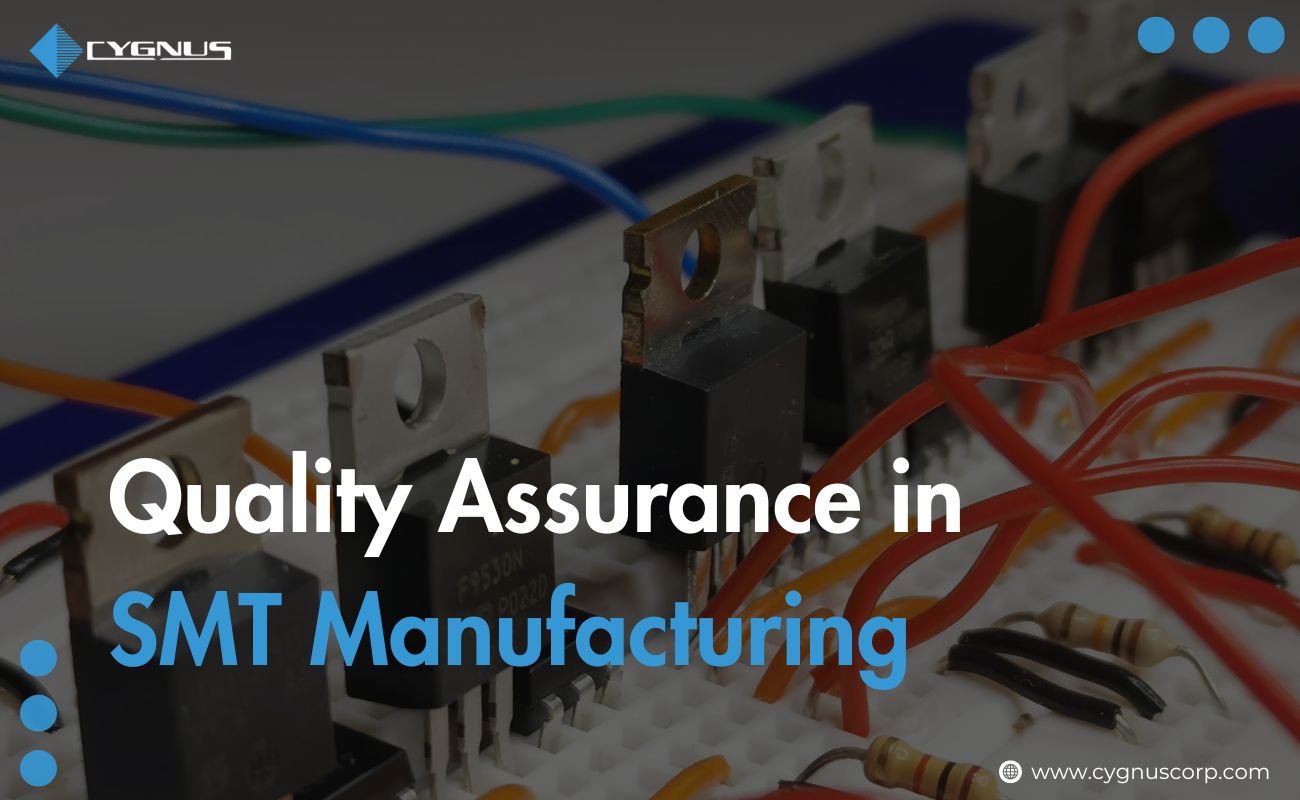One microscopic solder defect can be the reason your next product launch fails. In an industry where precision is everything, quality assurance in SMT manufacturing becomes the silent hero behind high-performance electronics. As devices shrink and functionality grows, manufacturers must adopt a rigorous SMT inspection process to catch issues before they cascade down the production line. From solder paste application to final testing, every stage of SMT quality assurance is designed to ensure zero-defect assemblies, maximum yield, and complete customer trust.
Why QA in SMT Manufacturing Matters More Than Ever?
Speed is everything, but so is accuracy. With products getting smaller, more complex, and more powerful, the margin for error has never been thinner. That’s why Quality Assurance in SMT Manufacturing isn’t just a support function, it’s a strategic necessity.
Modern production lines can assemble thousands of components per hour, but without a solid SMT inspection process, even a tiny misalignment or soldering flaw can lead to complete system failure. Early-stage issues, if left unchecked, can snowball into expensive recalls, warranty claims, and damaged brand reputation.
This is where SMT quality assurance steps in. It ensures that every component is correctly placed, every joint perfectly soldered, and every board compliant with industry standards. Tools like Automated Optical Inspection (AOI) make this possible by scanning boards in real-time, flagging even the most minute defects before they move further down the line. Simply put, effective QA turns high-speed production into high-reliability manufacturing.
Critical Stages Where QA Must Be Applied in SMT Production?
Every step in the SMT line offers an opportunity to catch issues early—before they escalate into costly SMT assembly defects. Here’s a breakdown of the critical QA stages and what to watch for at each point:
| Stage | What to Inspect | Why It Matters |
| Component Storage & Handling | Moisture levels, ESD protection | Prevent component damage that leads to latent failures |
| Stencil Printing | Paste alignment and volume using solder paste inspection (SPI) | SPI ensures consistent solder deposition, a major factor in joint reliability |
| Pick and Place | Accurate component placement, polarity, and alignment | Misplaced parts can result in shorts, open circuits, or failed functionality |
| Pre-Reflow Inspection | Visual check or machine validation of paste and placement | Helps identify visible flaws before permanent soldering |
| Reflow Soldering | Temperature profiling and zone control | Ensures strong, defect-free solder joints and adherence to SMT manufacturing standards |
| Post-Reflow Inspection | Use of Automated Optical Inspection (AOI) and X-ray as needed | Detects bridging, tombstoning, and hidden joint issues missed by manual checks |
| Functional Testing | Verifies electrical performance under real-world conditions | Confirms the board functions as intended before final assembly |
Applying thorough QA checks at these stages, manufacturers can dramatically reduce SMT assembly defects and consistently meet strict SMT manufacturing standards.
QA Tools and Techniques in SMT Production:
In high-speed electronics assembly, ensuring product reliability depends on a robust toolkit for detecting and preventing defects. Quality Assurance in SMT Manufacturing relies on several advanced tools and processes to maintain consistency and meet strict industry standards. Here are the key tools that form the backbone of SMT quality assurance:
- Solder Paste Inspection (SPI): Essential for verifying solder volume and alignment right after stencil printing. SPI prevents paste-related issues, which are a major cause of SMT assembly defects.
- Automated Optical Inspection (AOI): A cornerstone of the SMT inspection process, AOI uses high-resolution cameras to detect misaligned components, solder bridges, tombstoning, and missing parts—all in real time.
- X-ray Inspection Systems: Critical for inspecting hidden solder joints in components like BGAs and QFNs. Helps identify internal voids, cold joints, and insufficient solder.
- In-Circuit Testing (ICT): Tests electrical performance at the component level. ICT ensures all parts are functioning properly and connected as per the design.
- Functional Testing (FCT): Simulates real-world usage conditions to validate full board functionality. It’s often used in the final QA phase before shipment.
- Reflow Profiling Tools: Ensure the reflow oven maintains the correct thermal profile to meet SMT manufacturing standards. Inconsistent temperatures can lead to poor solder joint formation.
- Inspection and Traceability Software: Monitors every step of production and creates traceable records, helping manufacturers identify recurring issues and enforce process improvements.
These tools, when used together, form a comprehensive defense against defects and help maintain the highest levels of quality and reliability in SMT quality assurance.
Defect Detection and Classification: What to Look For?
In high-speed electronics production, even the smallest error can lead to major product failures. That’s why defect detection and classification is a core part of Quality Assurance in SMT Manufacturing. Spotting and categorizing flaws early helps reduce costly rework and ensures products meet strict SMT manufacturing standards.
🔍 Common Defects in SMT Assembly:
- Solder bridging – Unwanted solder connections between pads
- Tombstoning – One end of a component lifts off the pad
- Cold joints – Dull or cracked joints due to improper reflow
- Misaligned components – Caused by inaccurate placement or board movement
- Voids in solder joints – Pockets of air affecting reliability
Tools like Automated Optical Inspection (AOI) and X-ray systems are used in the SMT inspection process to catch these issues. AOI is particularly effective in spotting visible surface errors, while X-rays help identify hidden problems in BGAs and QFNs.
By maintaining a robust classification system and aligning with IPC-A-610 or similar industry guidelines, manufacturers can effectively reduce SMT assembly defects and meet global PCB quality control in SMT standards.
Quality Metrics That Actually Matter in SMT Manufacturing
While inspections are important, measuring quality is what helps manufacturers improve. Real SMT quality assurance isn’t just about catching defects—it’s about tracking, learning, and optimizing processes.
Here are the metrics that truly matter:
- First Pass Yield (FPY): Measures how many boards pass all QA checks the first time without rework. A low FPY indicates process issues.
- Defects Per Million Opportunities (DPMO): Tracks the frequency of defects relative to total inspection points.
- Cost of Quality (CoQ): Helps quantify the financial impact of QA efforts, including prevention, detection, and failure costs.
- Mean Time Between Failures (MTBF): Essential for long-term reliability analysis.
Integrating data from solder paste inspection (SPI), AOI, and electrical testing gives a complete picture of line health. This data helps pinpoint where in the Surface Mount Technology testing chain defects are introduced and how to eliminate them.
Common QA Mistakes in SMT Lines and How to Avoid Them?
Even experienced manufacturers can fall into bad habits that compromise quality. Avoiding these mistakes is key to consistent SMT quality assurance:
❌ Common Mistakes:
- Skipping reflow profiling – Leads to cold joints and weak solder connections.
- Over-reliance on manual inspection – Inconsistent and error-prone compared to automated systems like AOI.
- Neglecting SPI calibration – A poorly tuned solder paste inspection (SPI) machine can introduce more errors than it detects.
- Lack of cross-department feedback – QA insights not shared with design or process engineering teams mean problems get repeated.
- Infrequent updates to defect libraries in AOI/X-ray systems – Causes false negatives or unnecessary false alarms.
The solution? Build QA into every step—from design for manufacturability (DFM) to the final SMT inspection process—and ensure teams are trained and aligned with SMT manufacturing standards.
Future of QA in SMT: Smarter, Faster, More Predictive
As electronics become more complex, traditional inspection methods alone won’t be enough. The future of Quality Assurance in SMT Manufacturing is data-driven, predictive, and automated.
🔮 Key Trends to Watch:
- AI-Powered AOI Systems: Machine learning models reduce false positives and detect new defect types faster than rule-based systems.
- Closed-Loop Feedback Systems: Real-time analytics allow automatic adjustments in solder printing, placement, or reflow processes.
- Digital Twins and Simulation: Virtual models of the SMT line predict performance outcomes before real issues occur.
- Integrated Traceability: Linking QA data with MES and ERP systems helps track defects back to root causes instantly—boosting PCB quality control in SMT across the board.
With smarter tools and better data, the future of SMT quality assurance lies in automation, prediction, and continuous optimization—ensuring products meet not only today’s demands but tomorrow’s expectations.
Final Thoughts: Build Quality into the Process, Not Just at the End
Quality Assurance in SMT Manufacturing is no longer optional it’s essential. From solder paste to final functionality, each step of the SMT inspection process plays a role in delivering reliable, defect-free products. Leveraging tools like Automated Optical Inspection (AOI) and precise Surface Mount Technology testing, manufacturers can detect issues early, reduce waste, and meet growing quality demands. With smart processes and strong SMT quality assurance systems in place, success in high-volume production isn’t just possible it’s sustainable.
FAQs
Q1: What is the most important quality check in SMT manufacturing?
A: While all stages are crucial, SPI and AOI are often considered foundational because they catch issues early in the process before components are reflowed.
Q2: How do AOI and SPI differ in SMT QA?
A: SPI is used before reflow to inspect solder paste volume and placement, while AOI is used post-reflow to inspect solder joints and component alignment.
Q3: What causes most SMT defects and how can they be prevented?
A: Most defects stem from improper paste application, poor component handling, or reflow errors. Preventive measures include regular equipment calibration, using real-time QA data, and training staff on DFM principles.
Q4: Can AI improve quality assurance in SMT?
A: Yes. AI-driven AOI systems are increasingly capable of learning defect patterns, reducing false positives, and offering predictive insights that help avoid future faults.




